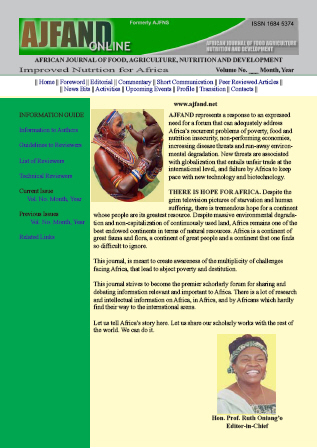
|
African Journal of Food, Agriculture, Nutrition and Development
Rural Outreach Program
ISSN: 1684-5358
EISSN: 1684-5358
Vol. 15, No. 4, 2015, pp. 10305-10316
|
 Bioline Code: nd15044
Bioline Code: nd15044
Full paper language: English
Document type: Research Article
Document available free of charge
|
|
|
African Journal of Food, Agriculture, Nutrition and Development, Vol. 15, No. 4, 2015, pp. 10305-10316
| en |
NUTRITIONAL EVALUATION OF SOME NEW MAIZE VARIETIES: EFFECTS ON GROWTH PERFORMANCE AND CARCASS TRAITS OF ALBINO RATS
Okai, Daniel Boye; Boateng, M.; Ewool, M. B.; Ankamaa, D. & Osarumwense, S. O.
Abstract
A study was carried out to ascertain the effects some new maize varieties: Obatanpa (OB), Opeaburoo (OP), Honampa (HO), Aseda (AS), Tintim (TT), Owanwa (OW) and Odomfo (OD) on the growth performance and carcass traits of albino rats. Aseda, Opeaburoo and Tintim are all white varieties and have been described as being moderately tolerant to drought and good for domestic purposes. Owanwa, Odomfo and Honampa on the other hand are all yellow varieties. The OW and OD varieties have a pro-vitamin A content of 6μg/g whilst HO has a pro-vitamin A content of 7μg/g. Obatanpa (OB) is a white and an open-pollinated Quality Protein Maize (QPM) variety grown widely by farmers in Ghana. Thirty-five weanling Wistar® rats with an average initial live weight of 36g were randomly allocated to seven isocaloric dietary treatments in a completely randomized design (CRD). There were five rats on each treatment, housed individually in plastic cages and each rat served as a replicate. Their growth performance was monitored for 28 days, after which the rats were euthanized and dissected to collect carcass data. The mean daily feed intakes and weight gains were similar (P>0.05) for the rats on the various dietary treatments. The feed conversion ratios (FCR) as well as feed cost per 100g weight gain were not significantly (P>0.05) influenced by the variety of maize in the diets. The abdominal fat colour score was affected by the dietary treatments with HO, OD and OW scoring 2 while treatments OB, OP, AS and TT scored 1. The carcass characteristics of all the albino rats on the seven dietary treatments were similar (P>0.05) except for empty gastrointestinal tract (GIT) weights which were higher (P<0.05) for HO and OD treatments. It was concluded that since the growth performance indicators were similar for all the dietary treatments, farmers can utilize any of these new varieties in their feeding operations but where enhanced carcass colour is desired HO, OD and OW could be the varieties of choice.
Keywords
Carcass; carotene; colour; drought tolerance; maize; obatanpa; variety; yield
|
| |
© Copyright 2015 - African Journal of Food, Agriculture, Nutrition and Development
Alternative site location: http://www.ajfand.net/
|
|
